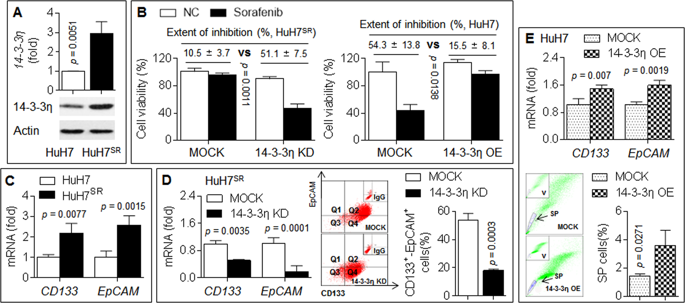Cell Death Discovery ( IF 6.1 ) Pub Date : 2019-07-19 , DOI: 10.1038/s41420-019-0200-8 Yongxin Qiu 1, 2 , Wenqi Shan 1, 3 , Ye Yang 1, 3 , Ming Jin 1, 3 , Yi Dai 1, 2 , Hanyu Yang 1, 3 , Ruonan Jiao 1, 2 , Yunwei Xia 1, 2 , Qinqiang Liu 2 , Liang Ju 2 , Guangming Huang 1, 2 , Jianping Zhang 1, 2 , Lihua Yang 1, 2 , Lei Li 1, 3 , Yuan Li 1, 3

|
Sorafenib resistance is one of the main obstacles to the treatment of advanced/recurrent hepatocellular carcinoma (HCC). Here, sorafenib-resistant HCC cells and xenografts in nude mice were used as experimental models. A cohort of patients with advanced recurrent HCC who were receiving sorafenib therapy was used to assess the clinical significance of this therapy. Our data showed that 14-3-3η maintained sorafenib resistance in HCC. An analysis of the underlying molecular mechanisms revealed that 14-3-3η stabilizes hypoxia-inducible factor 1α (HIF-1α) through the inhibition of ubiquitin-dependent proteasome protein degradation, which leads to the maintenance of cancer stem cell (CSC) properties. We further found that microRNA-16 (miR-16) is a competent miRNA that reverses sorafenib resistance by targeting the 3′-UTR of 14-3-3η and thereby inhibits 14-3-3η/HIF-1α/CSC properties. In HCC patients, significant negative correlations were found between the expression of miR-16 and 14-3-3η, HIF-1α, or CSC properties. Further analysis showed that low miR-16 expression but high 14-3-3η expression can prognosticate sorafenib resistance and poor survival. Collectively, our present study indicated that miR-16/14-3-3η is involved in sorafenib resistance in HCC and that these two factors could be potential therapeutic targets and biomarkers for predicting the response to sorafenib treatment.
中文翻译:

逆转肝细胞癌中索拉非尼耐药:表观遗传调控 14-3-3η/缺氧诱导因子 1α 的破坏
索拉非尼耐药是治疗晚期/复发性肝细胞癌(HCC)的主要障碍之一。在这里,使用索拉非尼耐药的肝癌细胞和裸鼠异种移植物作为实验模型。一组正在接受索拉非尼治疗的晚期复发性 HCC 患者被用来评估该疗法的临床意义。我们的数据表明,14-3-3η 在 HCC 中维持了索拉非尼耐药性。对潜在分子机制的分析表明,14-3-3η 通过抑制泛素依赖性蛋白酶体蛋白降解来稳定缺氧诱导因子 1α (HIF-1α),从而维持癌症干细胞 (CSC) 特性。我们进一步发现,microRNA-16 (miR-16) 是一种有效的 miRNA,它通过靶向 14-3-3η 的 3′-UTR 逆转索拉非尼耐药性,从而抑制 14-3-3η/HIF-1α/CSC 特性。在 HCC 患者中,miR-16 的表达与 14-3-3η、HIF-1α 或 CSC 特性之间存在显着负相关。进一步分析表明,低 miR-16 表达但高 14-3-3η 表达可以预测索拉非尼耐药和较差的生存率。总的来说,我们目前的研究表明 miR-16/14-3-3η 参与 HCC 索拉非尼耐药,这两个因素可能是预测索拉非尼治疗反应的潜在治疗靶点和生物标志物。











































 京公网安备 11010802027423号
京公网安备 11010802027423号